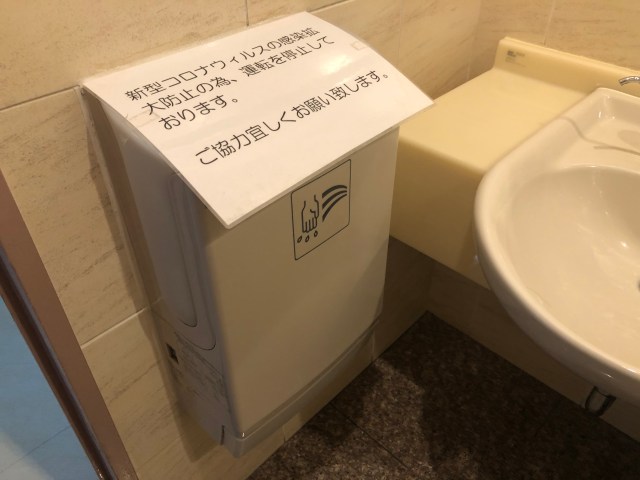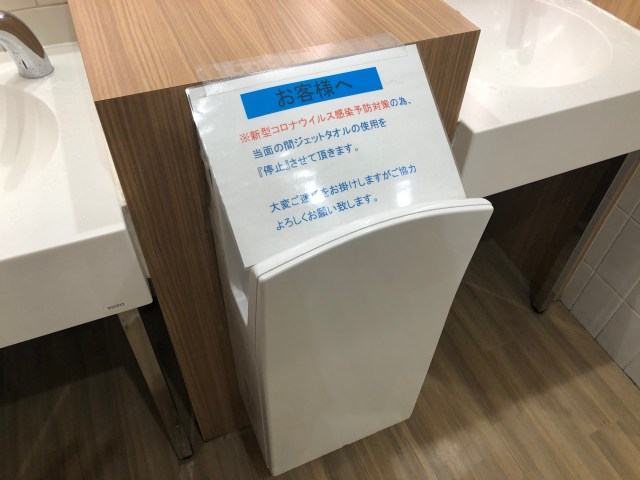
New study fears shutting them down might do more harm than good.
As we have often seen over the past year-and-a-half, every country has their own way of dealing with the threat of COVID-19. Japan has largely allowed business to continue, albeit with certain restrictions, in an effort to balance safety with maintaining the economy.
Whether this relatively lax approach was the right move is open for debate, but an interesting detail of it all was that, very early on into the pandemic, Japan swiftly shut down most, if not all, automatic hand dryers with extreme prejudice. In what seemed like the blink of the eye, every air dryer in sight was unplugged and taped over.
▼ Laminated placards typically serve a double purpose of apologizing for the inconvenience and providing an iron wall of security into the belly of the drying beast
Even before this coronavirus reared its ugly head, there had been a lot of debate over the hygiene of these contraptions. Opponents claim that they tend to suck in the impure restroom air that has been tainted with the mist of flushed toilets. However, studies have been conflicting on the overall effects of that, which suggests it largely depends on the type of machine and type of microorganism being dealt with.
Still, most would agree that shutting them down in the face of this then-unknown threat was a prudent move. Days then turned to weeks and weeks turned to months and now I can hardly remember what those obnoxiously loud boxes sound like anymore.
▼ Ah yeah… That takes me back.
It looks like that’s all about to change though, because on 12 April the Japan Business Federation has revised its Novel Coronavirus Infection Prevention Guidelines. As a part of their efforts to keep up with the changing times, they have lifted their embargo on hot air and are asking offices, factories, and commercial facilities to turn the dryers back on.
The federation commissioned a study on the matter with the Hygiene & Microbiology Research Center in Tokyo and found no increase in the amount of bacteria around the sections where hands are dried.
In addition, other experts have cited the number of COVID-19 infections traced back to public restrooms are “extremely” small, meaning the risk of a dryer-borne infection is also low. Not only that, but with no dryers it is feared that some people aren’t washing their hands properly – or at all – which increases the risk of viral transmission.
Naturally, with such a divisive machine, public opinion on the lifted ban was all over the map.
“So, why did they stop using it without any scientific basis in the first place?”
“Thank you! I’ve been having to wipe my hands on my pants like I did in grade school.”
“We got everyone using cloth bags, why not handkerchiefs too?”
“The place I usually go installed paper towels instead. I kind of hope they keep it that way.”
“Frankly, I’d be more worried about the toilet seat than the hand dryer.”
“It’s more dangerous to brush your teeth in those places but I still see people doing that.”
“Eh, I never used them anyway.”
“Those things don’t even get your hands dry anyway.”
“I just wish they put the whole setup outside. I hate having to wash my hands and then touch the same door that people who don’t wash use.”
The last comment would seem to have hit the crux of the matter–a bigger threat could well be the door which is shared by hand washers, quick rinsers, and the sullied alike. Also, installing the dryer outside of the germy restroom air would help clear up a lot of the concerns about them.
But that kind of renovation would be a tall order for most places, so I’ll be sticking to trying to guess which part of the door handle is least touched by others and to using my handkerchief. Those little cloths have really grown on me and make me look like a right dandy.
Source: The Sankei News, My Game News Flash
Photos ©SoraNews24
● Want to hear about SoraNews24’s latest articles as soon as they’re published? Follow us on Facebook and Twitter!


 Could Coronavirus be helping prevent the spread of influenza? Japanese Twitter speculates
Could Coronavirus be helping prevent the spread of influenza? Japanese Twitter speculates Can Amazon Japan’s low-rated clothes drying bag save us in a pinch?
Can Amazon Japan’s low-rated clothes drying bag save us in a pinch? Crummy Japanese dish dryer still gets five-star reviews on Amazon for unexpected reason
Crummy Japanese dish dryer still gets five-star reviews on Amazon for unexpected reason New heated clothes hanger will dry your clothes in any type of weather
New heated clothes hanger will dry your clothes in any type of weather 5 tips for staying healthy while traveling in Japan this winter!
5 tips for staying healthy while traveling in Japan this winter! Red light district sushi restaurant in Tokyo shows us just how wrong we were about it
Red light district sushi restaurant in Tokyo shows us just how wrong we were about it McDonald’s new Happy Meals offer up cute and practical Sanrio lifestyle goods
McDonald’s new Happy Meals offer up cute and practical Sanrio lifestyle goods Akihabara pop-up shop sells goods made by Japanese prison inmates
Akihabara pop-up shop sells goods made by Japanese prison inmates Tokyo Tsukiji fish market site to be redeveloped with 50,000-seat stadium, hotel, shopping center
Tokyo Tsukiji fish market site to be redeveloped with 50,000-seat stadium, hotel, shopping center Japanese ramen restaurants under pressure from new yen banknotes
Japanese ramen restaurants under pressure from new yen banknotes Pokémon Sleep camping suite and guestrooms coming to Tokyo Hyatt along with giant Snorlax burgers
Pokémon Sleep camping suite and guestrooms coming to Tokyo Hyatt along with giant Snorlax burgers Sandwiches fit for a sumo served up in Osaka【Taste Test】
Sandwiches fit for a sumo served up in Osaka【Taste Test】 Historical figures get manga makeovers from artists of Spy x Family, My Hero Academia and more
Historical figures get manga makeovers from artists of Spy x Family, My Hero Academia and more Anime girl English teacher Ellen-sensei becomes VTuber/VVTUber and NFT
Anime girl English teacher Ellen-sensei becomes VTuber/VVTUber and NFT Do ANA international inflight meals taste better on the ground than they do in the air?
Do ANA international inflight meals taste better on the ground than they do in the air? All-you-can-drink Starbucks and amazing views part of Tokyo’s new 170 meter-high sky lounge
All-you-can-drink Starbucks and amazing views part of Tokyo’s new 170 meter-high sky lounge More foreign tourists than ever before in history visited Japan last month
More foreign tourists than ever before in history visited Japan last month French Fries Bread in Tokyo’s Shibuya becomes a hit on social media
French Fries Bread in Tokyo’s Shibuya becomes a hit on social media Studio Ghibli releases new action figures featuring Nausicaä of the Valley of the Wind characters
Studio Ghibli releases new action figures featuring Nausicaä of the Valley of the Wind characters New private rooms on Tokaido Shinkansen change the way we travel from Tokyo to Kyoto
New private rooms on Tokaido Shinkansen change the way we travel from Tokyo to Kyoto Starbucks reopens at Shibuya Scramble Crossing with new look and design concept
Starbucks reopens at Shibuya Scramble Crossing with new look and design concept Studio Ghibli glasses cases let anime characters keep an eye on your spectacles
Studio Ghibli glasses cases let anime characters keep an eye on your spectacles Beautiful Ghibli sealing wax kits let you create accessories and elegant letter decorations【Pics】
Beautiful Ghibli sealing wax kits let you create accessories and elegant letter decorations【Pics】 Studio Ghibli releases Kiki’s Delivery Service chocolate cake pouches in Japan
Studio Ghibli releases Kiki’s Delivery Service chocolate cake pouches in Japan New definition of “Japanese whiskey” goes into effect to prevent fakes from fooling overseas buyers
New definition of “Japanese whiskey” goes into effect to prevent fakes from fooling overseas buyers Our Japanese reporter visits Costco in the U.S., finds super American and very Japanese things
Our Japanese reporter visits Costco in the U.S., finds super American and very Japanese things Studio Ghibli unveils Mother’s Day gift set that captures the love in My Neighbour Totoro
Studio Ghibli unveils Mother’s Day gift set that captures the love in My Neighbour Totoro New Japanese KitKat flavour stars Sanrio characters, including Hello Kitty
New Japanese KitKat flavour stars Sanrio characters, including Hello Kitty New Pokémon cakes let you eat your way through Pikachu and all the Eevee evolutions
New Pokémon cakes let you eat your way through Pikachu and all the Eevee evolutions Disney princesses get official manga makeovers for Manga Princess Cafe opening in Tokyo
Disney princesses get official manga makeovers for Manga Princess Cafe opening in Tokyo Sales of Japan’s most convenient train ticket/shopping payment cards suspended indefinitely
Sales of Japan’s most convenient train ticket/shopping payment cards suspended indefinitely Sold-out Studio Ghibli desktop humidifiers are back so Totoro can help you through the dry season
Sold-out Studio Ghibli desktop humidifiers are back so Totoro can help you through the dry season Japanese government to make first change to romanization spelling rules since the 1950s
Japanese government to make first change to romanization spelling rules since the 1950s Ghibli founders Toshio Suzuki and Hayao Miyazaki contribute to Japanese whisky Totoro label design
Ghibli founders Toshio Suzuki and Hayao Miyazaki contribute to Japanese whisky Totoro label design Doraemon found buried at sea as scene from 1993 anime becomes real life【Photos】
Doraemon found buried at sea as scene from 1993 anime becomes real life【Photos】 Tokyo’s most famous Starbucks is closed
Tokyo’s most famous Starbucks is closed One Piece characters’ nationalities revealed, but fans have mixed opinions
One Piece characters’ nationalities revealed, but fans have mixed opinions We asked a Uniqlo employee what four things we should buy and their suggestions didn’t disappoint
We asked a Uniqlo employee what four things we should buy and their suggestions didn’t disappoint Princesses, fruits, and blacksmiths: Study reveals the 30 most unusual family names in Japan
Princesses, fruits, and blacksmiths: Study reveals the 30 most unusual family names in Japan Japanese store curses toilet paper supply to protect it from thefts
Japanese store curses toilet paper supply to protect it from thefts In Japan the gates to Hell are disguised as a laundromat, and four other freaky coin-laundry finds
In Japan the gates to Hell are disguised as a laundromat, and four other freaky coin-laundry finds Toyama Prefectural University able to locate potential COVID-19 clusters from raw sewage
Toyama Prefectural University able to locate potential COVID-19 clusters from raw sewage Dry and iron your laundry hands-free and fast with Village Vanguard’s hot air bag clothes dryer
Dry and iron your laundry hands-free and fast with Village Vanguard’s hot air bag clothes dryer Seriously unlucky Chinese man takes an actual arrow to the knee while doing laundry
Seriously unlucky Chinese man takes an actual arrow to the knee while doing laundry Seven Japanese beauty products recommended by Twitter that are perfect for lazy girls
Seven Japanese beauty products recommended by Twitter that are perfect for lazy girls Japanese Red Cross releases important video on dealing with COVID-19 in a different way
Japanese Red Cross releases important video on dealing with COVID-19 in a different way Nara University study finds some common teas can neutralize COVID-19
Nara University study finds some common teas can neutralize COVID-19 Tokyo plan to give 100,000 yen to residents who get infected with coronavirus sparks backlash
Tokyo plan to give 100,000 yen to residents who get infected with coronavirus sparks backlash Politician’s disgusting mask gaffe grosses out Japan【Video】
Politician’s disgusting mask gaffe grosses out Japan【Video】 First-of-its-kind towel is totally worth its 5,000 yen price, customers say
First-of-its-kind towel is totally worth its 5,000 yen price, customers say Hot spring in Gunma Prefecture found to reduce COVID-19 infectivity by over 90 percent
Hot spring in Gunma Prefecture found to reduce COVID-19 infectivity by over 90 percent “I’ll kill you!” says Japanese schoolgirl when convenience store won’t let her use restroom
“I’ll kill you!” says Japanese schoolgirl when convenience store won’t let her use restroom We try making dried flowers using a special, fast technique and get unexpectedly good results
We try making dried flowers using a special, fast technique and get unexpectedly good results Did you know you can “wash” your smartphone at McDonald’s in Japan? 【Video】
Did you know you can “wash” your smartphone at McDonald’s in Japan? 【Video】 Set your hair with the awesome new Cardcaptor Sakura Sealing Wand anime hair dryer
Set your hair with the awesome new Cardcaptor Sakura Sealing Wand anime hair dryer
Leave a Reply